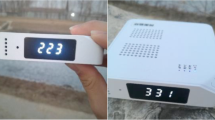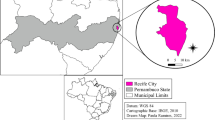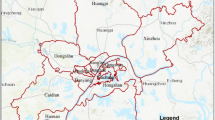Abstract
In recent years, the deterioration of air quality due to high levels of particulate matter (PM: especially PM 10 and PM 2.5) has become a transboundary environmental problem in countries of the East Asia Pacific region. People tend to change their behavior in response to bad air quality, and those changes generate a wide range of socioeconomic implications. Despite their significance, however, the effects of PM on human behavior, especially behaviors involving outdoor activities, have not been sufficiently examined. This study employed panel analyses to empirically investigate differences in the preferences for recreational spaces with changes in the PM 2.5 level in Seoul, South Korea, from March 1 to June 30, 2017. We found a statistically significant relationship between the PM 2.5 level and the number of visitors to particular types of study sites in the daytime on weekdays and all days of the weekends. In both time groups, the number of visitors in open spaces decreased, while those in commercial spaces increased with heightened PM 2.5 level. But the numbers of visitors to indoor sports facilities showed no significant changes with the level of PM 2.5. We also found differing levels of pedestrian volume change according to sub-categories of open and commercial spaces. As an early empirical study of the impact of PM on human behavior, this work will help evaluate environmental policies and make possible safer community development planning.

Similar content being viewed by others
Change history
28 July 2020
A Correction to this paper has been published: https://doi.org/10.1007/s00168-020-01013-2
References
Ailshire J, Karraker A, Clarke P (2017) Neighborhood social stressors, fine particulate matter air pollution, and cognitive function among older US adults. Soc Sci Med 172:56–63
Air Korea (n.d.) Forecasting and warning of air quality. http://www.airkorea.or.kr/web/dustForecast?pMENU_NO=113
Amodio M, Dambruoso PR, de Gennaro G, de Gennaro L, Loiotile AD, Marzocca A (2014) Indoor air quality (IAQ) assessment in a multistorey shopping mall by high-spatial-resolution monitoring of volatile organic compounds (VOC). Environ Sci Pollut Res 21(23):13186–13195
Ban J, Zhou L, Zhang Y, Anderson GB, Li T (2017) The health policy implications of individual adaptive behavior responses to smog pollution in urban China. Environ Int 106:144–152
Beckett KP, Freer-Smith PH, Taylor G (2000) Particulate pollution capture by urban trees: effect of species and windspeed. Glob Change Biol 6(8):995–1003
Bremer C (2016) Air pollution to cause 6–9 million premature deaths and cost 1% GDP by 2060. http://www.oecd.org/environment/air-pollution-to-cause-6-9-million-premature-deaths-and-cost-1-gdp-by-2060.htm. Retrieved 3 Apr 2019
Brook R, Rajagopalan S, Pope A, Brook J, Bhatnagar A, Diez-Roux A, Holguin F, Hong Y, Luepker R, Mittleman M, Peters A, Siscovick D, Smith S, Whitsel L, Kaufman J (2010) Particulate matter air pollution and cardiovascular disease: an update to the scientific statement from the American Heart Association. Circulation 121(21):2331–2378
Brunekreef B, Holgate ST (2002) Air pollution and health. Landcet 360:1233–1242
Chan LY, Kwok WS, Chan CY (2000) Human exposure to respirable suspended particulate and airborne lead in different roadside microenvironments. Chemosphere 41(1–2):93–99
Chan LY, Kwok WS, Lee SC, Chan CY (2001) Spatial variation of mass concentration of roadside suspended particulate matter in metropolitan Hong Kong. Atmos Environ 35(18):3167–3176
Chao CY, Chan GY (2001) Quantification of indoor VOCs in twenty mechanically ventilated buildings in Hong Kong. Atmos Environ 35(34):5895–5913
Chen CM, Lin YL, Hsu CL (2017) Does air pollution drive away tourists? A case study of the Sun Moon Lake National Scenic Area, Taiwan. Transp Res Part D Transp Environ 53:398–402
Chen B, Song Y, Kwan M, Huang B, Xu B (2018) How do people in different places experience different levels of air pollution? Using worldwide Chinese as a lens. Environ Pollut 238:874–883
Colman G, Dave D (2013) Exercise, physical activity, and exertion over the business cycle. Soc Sci Med 93:11–20
Croissant Y, Millo G (2008) Panel data econometrics in R: the plm package. J Stat Softw 27(2):1–43
Dadvand P, de Nazelle A, Triguero-Mas M, Schembari A, Cirach M, Amoly E, Figueras F, Basagana X, Ostro B, Nieuwenhuijsen M (2012) Surrounding greenness and exposure to air pollution during pregnancy: an analysis of personal monitoring data. Environ Health Perspect 120(9):1286–1290
Fallah-Shorshani M, Hatzopoulou M, Ross N, Patterson Z, Weichenthal S (2018) Evaluating the impact of neighborhood characteristics on differences between residential and mobility-based exposures to outdoor air pollution. Environ Sci Technol 52:10777–10786
Frank LD, Sallis JF, Conway TL, Chapman JE, Saelens BE, Bachman W (2006) Many pathways from land use to health: associations between neighborhood walkability and active transportation, body mass index, and air quality. J Am Plan Assoc 72(1):75–87
Giles LV, Barn P, Künzli N, Romieu I, Mittleman MA, van Eeden S (2010) From good intentions to proven interventions: effectiveness of actions to reduce the health impacts of air pollution. Environ Health Perspect 119(1):29–36
Greene W (2003) Econometric analysis. Prentice Hall, Upper Saddle River
Gujarati DN, Porter DC (2009) Basic econometrics, 5th edn. McGraw-Hill Irwin, Boston
Hahm Y, Yoon H, Jung D, Kwon H (2017) Do built environments affect pedestrians’ choices of walking routes in retail districts? A study with GPS experiments in Hongdae retail district in Seoul, South Korea. Habitat Int 70:50–60
Hahm Y, Yoon H, Choi Y (2019) The effect of built environments on the walking and shopping behaviors of pedestrians; a study with GPS experiment in Sinchon retail district in Seoul, South Korea. Cities 89:1–13
Han S (2019) Geoje Geosung elementary school opens a virtual reality sports room. Gyeongnam Ilbo. http://www.gnmaeil.com/news/articleView.html?idxno=409233. Retrieved 4 Apr 2019
Hausman JA (1978) Specification tests in econometrics. Econometrica 46(6):1251–1271
Hu J, Li N (2015) Variation of PM2.5 concentrations in shopping malls in Autumn, Changsha. Procedia Eng 121:692–698
Jasaitis D, Vasiliauskienė V, Chadyšienė R, Pečiulienė M (2016) Surface ozone concentration and its relationship with UV radiation, meteorological parameters and radon on the eastern coast of the Baltic Sea. Atmosphere 7(2):27
Jeon M (2019) Why do elders not wear masks? Minor Dust Hazard Information Alienation Severity, Countermeasure Limitation. Kukmin Ilbo. Retrieved July 5, 2019. http://news.kmib.co.kr/article/view.asp?arcid=0924061971&code=14130000&cp=nv
Kang CD (2016) Spatial access to pedestrians and retail sales in Seoul, Korea. Habitat Int 57:110–120
Karagulian F, Belis CA, Dora CFC, Prüss-Ustün AM, Bonjour S, Adair-Rohani H, Amann M (2015) Contributions to cities’ ambient particulate matter (PM): a systematic review of local source contributions at global level. Atmos Environ 120:475–483
Kim KH, Kabir E, Kabir S (2015) A review on the human health impact of airborne particulate matter. Environ Int 74:136–143
Lee S (2019) The economy is screaming because of fine dust. Hankook Ilbo. http://www.hankookilbo.com/News/Read/201903061486045784?did=NAanddtype=anddtypecode=andprnewsid
Lee J, Kim H, Hong Y, Kwon H, Schwartz J, Christiani D (2000) Air pollution and daily mobility in seven major cities of Korea, 1991–1997. Environ Res Sect A 84:247–254
Liao D, Duan Y, Whitsel EA, Zheng ZJ, Heiss G, Chinchill VM, Lin HM (2004) Association of higher levels of ambient criteria pollutants with impaired cardia autonomic control: a population-based study. Am J Epidemiol 159:768–777
Lü J, Liang L, Feng Y, Li R, Liu Y (2015) Air pollution exposure and physical activity in China: current knowledge, public health implications, and future research needs. Int J Environ Res Public Health 12(11):14887–14897
Ministry of Environment (2016) What is particulate matter? https://www.me.go.kr/issue/finedust/ebook.pdf
Na S (2019) Fine dust disaster is suffocating the economy. Kookkim Ilbo. http://news.kmib.co.kr/article/view.asp?arcid=0924060278andcode=11151100andcp=nv
Nyhan M, Misstear BD, McNabola A (2014) Comparison of particulate matter does and acute heart rate variability response in cyclists, pedestrians, bus and train passengers. Sci Total Environ 468–469:821–831
OECD (2014) The cost of air pollution: health impacts of road transport. OECD Publishing, Paris. https://doi.org/10.1787/9789264210448-en
OECD (2018) Regions and cities at a glance 2018—KOREA. OECD Publishing, Paris. https://www.oecd.org/cfe/KOREA-Regions-and-Cities-2018.pdf
Oh P (2019) To prevent students’ vicious circle of health issues… Schools should play a role in health. Chosun Edu. http://edu.chosun.com/site/data/html_dir/2019/01/24/2019012400795.html
Omori T, Fujimoto G, Yoshimura I, Nitta H, Ono M (2003) Effects of particulate matter on daily mortality in 13 Japanese cities. J Epidemiol 13(6):314–322
Ostro B, Feng WY, Broadwin R, Green S, Lipsett M (2006) The effects of components of fine particulate air pollution on mortality in California: results from CALFINE. Environ Health Perspect 115(1):13–19
Park Y, Kwan M (2017) Individual exposure estimates may be erroneous when spatiotemporal variability of air pollution and human mobility are ignored. Health Place 43:85–94
Pope CA, Dockery DW (2006) Health effects of fine particulate air pollution: lines that connect. J Ari Waste Manag Assoc 56:709–742
Rakowska A, Wong KC, Townsend T, Chan KL, Westerdahl D, Ng S (2014) Impact of traffic volume and composition on the air quality and pedestrian exposure in urban street canyon. Atmos Environ 98:260–270
Reis S, Liska T, Vieno M, Carnell E, Beck R, Clemens T, Dragosits U, Tomlinson S, Leaver D, Heal M (2018) The influence of residential and workday population mobility on exposure to air pollution in the UK. Environ Int 121:803–813
Salonen HJ, Pasanen AL, Lappalainen SK, Riuttala HM, Tuomi TM, Pasanen PO (2009) Airborne concentrations of volatile organic compounds, formaldehyde and ammonia in Finnish office buildings with suspected indoor air problems. J Occup Environ Hyg 6(3):200–209
Simpson R, Williams G, Petroeschevsky A, Best T, Morgan G, Denison L, Hinwood A, Neville G, Neller A (2005) The short-term effects of air pollution on daily mortality in four Australian cities. Aust NZ J Public Health 29(3):205–212
Song Y, Wang X, Maher BA, Li F, Xu C, Liu X (2016) The spatial-temporal characteristics and health impacts of ambient fine particulate matter in China. J Clean Prod 112:1312–1318
Steinle S, Reis S, Sabel C (2013) Quantifying human exposure to air pollution-moving from static monitoring to spatio-temporally resolved personal exposure assessment. Sci Total Environ 443:184–193
Vaida V (2005) Sunlight initiated atmospheric photochemical actions. Int J Photoenergy 7(2):61–70
WHO Global Ambient Air Quality Database (2018) World Health Organization, World Health Organization, 22 Jan 2019. www.who.int/airpollution/data/cities/en/
Wu CF, Woodward A, Li YR, Kan H, Balasubramanian R, Latif MT et al (2017) Regulation of fine particulate matter (PM2.5) in the Pacific Rim: perspectives from the APRU Global Health Program. Air Qual Atmos Health 10(9):1039–1049
Yoo S, Kim J, Ryu K (2014) Using big data strategy for the development of the communication industry. In: International conference on web-age information management. Springer, Cham, pp 349–359
Yoon H (2017) Transforming the economic value of hillside housing—a case study of Seoul, South Korea. Urban For Urban Green 24:35–44
Yoon H (2019) Effects of particulate matter (PM10) on tourism sales revenue: a generalized additive modeling approach. Tour Manag 74:358–369
Yu H, Russell A, Mulholland J, Huang Z (2018) Using cell phone location to assess misclassification errors in air pollution exposure estimation. Environ Pollut 233:261–266
Acknowledgements
This work was supported by the BK 21 Plus Project in 2019 (Seoul National University Interdisciplinary Program in Landscape Architecture, Global leadership program toward innovative green infrastructure), Social Science Program through the National Research Foundation of Korea funded by the Ministry of Education (Grant Number: NRF-2017S1A3A2066771), the Ministry of Education of the Republic of Korea and the National Research Foundation of Korea (Grant Number: NRF-2017S1A5A8020226), and Creative-Pioneering Researchers Program through Seoul National University (SNU).
Author information
Authors and Affiliations
Corresponding author
Additional information
Publisher's Note
Springer Nature remains neutral with regard to jurisdictional claims in published maps and institutional affiliations.
Rights and permissions
About this article
Cite this article
Choi, Y., Yoon, H. & Kim, D. Where do people spend their leisure time on dusty days? Application of spatiotemporal behavioral responses to particulate matter pollution. Ann Reg Sci 63, 317–339 (2019). https://doi.org/10.1007/s00168-019-00926-x
Received:
Accepted:
Published:
Issue Date:
DOI: https://doi.org/10.1007/s00168-019-00926-x




